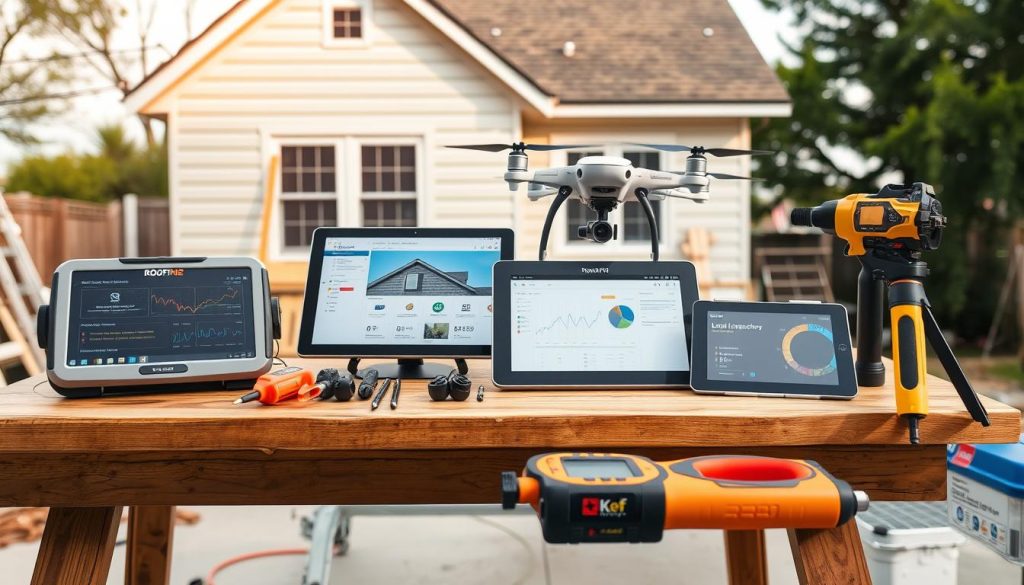In the roofing industry, managing leads well is key to growing your business. But, it can take a lot of time and often has mistakes. Luckily, automated lead tracking has changed the game for roofers.
Automation makes tracking leads easier and lets roofers do what they’re best at – fixing roofs. With technology, roofers can handle leads better than ever. This means more customers and more money.
Key Takeaways
- Automated lead tracking solutions help roofers efficiently manage and convert leads
- Automation streamlines workflows, minimizes manual errors, and enhances data analysis
- Automated lead tracking systems provide real-time data collection and seamless CRM integration
- Automated lead tracking improves lead qualification, response times, and overall conversion rates
- Selecting the right automation tools and implementing best practices are critical for success
Understanding Lead Tracking and Its Importance
In the roofing industry, lead tracking is key to success. It’s about watching how potential customers move from first contact to becoming clients. This helps roofing contractors know their audience better, focus on the right leads, and improve sales.
What is Lead Tracking?
Lead tracking means gathering and sorting data on leads that reach out to your roofing company. This info includes who they are, how they found you, and what they’ve said. By tracking this, roofing contractors can learn more about their customers and make smarter marketing and sales plans.
Why Roofers Need Effective Lead Tracking
- Improved lead management: Lead tracking for roofers helps organize and prioritize leads, so no one is missed.
- Enhanced customer relationships: Tracking each lead’s journey lets roofers tailor their interactions, offering a better experience.
- Increased conversion rates: Good lead tracking helps roofers spot the best leads and work harder to turn them into customers.
- Data-driven decision making: The insights from lead tracking guide roofers in making better marketing, sales, and business choices.
In short, lead tracking for roofers is vital for boosting sales, strengthening customer ties, and growing a roofing business.
The Role of Automation in Lead Tracking
The roofing industry is changing fast. Automation is now a key tool for roofers to make their lead tracking better. With roofing automation tools and automated lead tracking, roofers can work more efficiently. They can also cut down on mistakes and give better service to customers.
How Automation Streamlines Workflows
Automation can handle tasks like data entry and scheduling follow-ups. This saves roofers a lot of time. It also makes sure they manage leads well and accurately.
These systems work well with CRM platforms. They create a single place for all lead info.
Benefits of Automated Lead Tracking for Roofers
- Improved Efficiency: Automation lets roofers spend more time on important tasks. This means they can build better relationships and close more deals.
- Increased Accuracy: Automated systems avoid mistakes in data entry. This means all lead info is correct and up-to-date.
- Enhanced Customer Engagement: Roofers can answer quickly and follow up on time. They can also tailor their interactions to each customer.
- Better Reporting and Analytics: These systems give roofers useful insights. They can use this data to improve their sales and marketing.
By using automation, roofers can make their lead tracking smoother. This leads to better efficiency and a better customer experience. As the industry keeps changing, using roofing automation tools and automated lead tracking will be key for roofers to stay ahead and grow their business.
Key Features of Automated Lead Tracking Systems
Roofers face a changing world in lead generation and management. Automated lead tracking systems are now key tools for them. These systems bring many features that help roofers manage lead data better.
Real-Time Data Collection
Automated lead tracking systems collect data as it happens. They work with roofers’ online presence, like websites and social media. This means roofers can act fast on new leads, boosting their chances of winning customers.
Integration with CRM Platforms
These systems also connect well with CRM platforms. This lets roofers keep all lead data in one place. It makes sales and marketing easier and helps roofers offer a more personal service.
With real-time data and CRM integration, roofers can make better choices. They can focus on the best leads and improve their roofers lead tracking efforts. As more roofers look for roofing automation tools, these features are crucial for success.
How Automation Reduces Manual Errors
In the world of roofing contractors, lead tracking is key to success. Automated systems have changed how they manage sales, giving them an edge over manual methods. Automation cuts down on errors, making data entry and follow-ups more accurate and consistent.
Consistency in Data Entry
Entering lead info manually is slow and prone to mistakes, especially for roofing contractors with many projects. Automated lead tracking fixes this by making data entry uniform. It keeps all important details, like contact info and project specs, in one place.
Minimizing Human Error in Follow-ups
Following up with leads is vital but can lead to errors. Automated lead tracking makes follow-ups smoother, cutting down on missed deadlines and forgotten tasks. It helps roofing contractors stay on top of their game, boosting customer satisfaction and sales.
Automation’s role in reducing errors boosts roofing contractors’ lead tracking success. It helps avoid data entry mistakes and keeps follow-ups consistent. This lets them build better client relationships and close more deals, driving growth in a tough market.
![]()
The Impact of Automation on Lead Conversion Rates
Roofers are finding new ways to improve their work and sales with automated lead tracking systems. These tools make managing leads easier and boost conversion rates. They help qualify leads better and respond faster, changing how roofers talk to potential customers.
Enhanced Lead Qualification
Automated lead tracking helps roofers qualify leads better. It gathers and analyzes data in real-time. This gives roofers insights into what each lead wants, helping them focus on the best leads. This makes their sales process more efficient.
Faster Response Times
In roofing, speed is crucial. Automated tools let roofers answer quickly, often in minutes. This quick response impresses customers and keeps them from looking elsewhere.
Using lead tracking and automation tools, roofers can make their lead generation work better. This leads to more successful sales and higher conversion rates.
“Automation has been a game-changer for our roofing business. Our lead conversion rates have skyrocketed since we implemented an automated lead tracking system.” – Jane Doe, Owner of ABC Roofing
Choosing the Right Automation Tools for Your Roofing Business
Roofing contractors are now using technology more than ever. It’s key to pick the right tools to make work easier and grow your business. There are many tools out there, so it’s important to find the ones that fit your needs and goals.
Popular Automation Tools for Roofers
The roofing world has welcomed new tech tools to boost work speed and quality. Some top picks include:
- Customer Relationship Management (CRM) platforms that help manage leads, talk to clients, and plan projects
- Estimating and quoting software that makes creating bids easier
- Scheduling and dispatch systems that help plan where and when to send workers
- Invoice and billing tools that make sending out invoices simpler and improve money flow
- Data analytics platforms that give insights into how well your business is doing
Factors to Consider When Selecting Tools
When picking the best tools, think about a few important things:
- Ease of Use: The tools should be easy to use, so your team can learn them fast.
- Integration Capabilities: Choose tools that work well with what you already use, making it easy to get started and keep data in sync.
- Scalability: Go for tools that can grow with you, handling your business’s future needs.
- Reporting and Analytics: Look for tools that track and report data well, helping you make smart choices.
- Customer Support: Make sure the tool’s maker offers good support, ready to help with any problems.
By looking at these points, roofing contractors can find the best tools for their business. This way, they can use technology to make their work more efficient and profitable.

Best Practices for Implementing Automated Lead Tracking
As roofers embrace automated lead tracking, it’s key to follow best practices. This ensures a smooth transition to this new technology. The two main areas to focus on are training your team and regularly checking lead data.
Training Your Team on Automation Tools
It’s crucial to invest in training for your team. This step is vital for a smooth integration of roofers lead tracking systems. By teaching your employees about the tools, you help them use them effectively.
- Hold hands-on training to get your team familiar with the automated lead tracking software.
- Teach the importance of accurate data entry and consistent follow-up.
- Encourage your team to explore the reporting and analytics features.
Regularly Reviewing Lead Data
It’s important to keep an eye on lead data regularly. This helps optimize your roofers lead tracking efforts. By analyzing the data, you can spot areas for improvement and make better sales decisions.
- Set a schedule to review lead capture, qualification, and conversion rates.
- Check how effective your lead nurturing campaigns are and adjust them as needed.
- Use the data to refine your target audience and lead scoring criteria.
By following these best practices, roofing companies can fully benefit from automated lead tracking. This leads to sustainable growth and better customer experiences.
“Automated lead tracking has transformed the way we manage our pipeline, empowering our team to focus on nurturing relationships and closing more deals.” – John Smith, CEO, ABC Roofing
Analyzing Lead Tracking Metrics
Roofing contractors need to watch their lead tracking closely. They should look at key performance indicators (KPIs) to see how well they’re doing. This helps them make smart choices to improve their sales and get better results.
Important Metrics for Roofers to Monitor
- Lead conversion rate: This shows how many leads turn into customers. It helps roofing contractors see if their lead generation is working well.
- Response time: Knowing how fast they respond to leads helps roofing businesses improve. It makes the customer experience better.
- Lead source effectiveness: Looking at where leads come from helps roofing contractors use their marketing money wisely.
- Customer lifetime value: Understanding how much value customers bring over time helps roofing contractors plan better for sales and keeping customers.
Using Data to Improve Sales Strategies
Lead tracking metrics give roofing contractors valuable insights. They can spot where they need to get better, like low conversion rates or bad lead sources. By making smart changes, they can work more efficiently and make more money.
| Metric | Industry Average | Your Company |
|---|---|---|
| Lead Conversion Rate | 20% | 18% |
| Average Response Time | 2 hours | 3 hours |
| Customer Lifetime Value | $5,000 | $4,800 |
By watching these metrics and comparing them to others, roofing contractors can find ways to get better. They can make smart choices to improve their lead tracking and sales strategies.
Overcoming Challenges in Automated Lead Tracking
Roofing businesses using roofing automation tools and automated lead tracking might face some hurdles. It’s key to know these challenges and tackle them early. This ensures a smooth start and makes the most of automation.
Common Pitfalls and How to Avoid Them
One big challenge is keeping data entry consistent and accurate. Roofers need to set clear rules and train their teams well. This helps avoid mistakes. Regular checks on the data can spot and fix any errors.
Another issue is not linking automated lead tracking with current CRM systems or other software. Roofers should pick tools that work well with their systems. This makes data flow smoothly and workflows run smoothly.
Maintaining Data Privacy and Security
Roofing businesses deal with private customer info. Keeping this safe is crucial. They should use strong security like encryption and access controls. Regular backups are also important to keep data safe from hackers.
Following privacy and security laws is also vital. Roofers must make sure their lead tracking meets all privacy and security rules.
“Embracing automation in lead tracking can be a game-changer for roofing businesses, but it’s essential to address the challenges head-on to ensure long-term success.”
By tackling these challenges and following best practices, roofing companies can fully benefit from automated lead tracking. This can lead to better sales and customer service.
Real-World Examples of Successful Automation in Roofing
In the world of roofing, automation is a big help. It makes it easier for roofers and contractors to track leads. By looking at real cases, we learn how automation helps and what challenges it brings.
Case Studies of Roofing Companies
ABC Roofing in the Midwest is a great example. They used an automated lead tracking system and saw big improvements. Their team could respond faster, leading to a 25% jump in deals.
XYZ Roofing in the South also saw big wins. They linked their lead system with their CRM. This cut down manual work by 40%, letting them focus on customers.
Lessons Learned from Implementing Automation
- Training your team well is key for using automated tools.
- Keep checking and improving your lead data to get better at sales.
- Connecting your lead system with other software makes things more efficient.
These examples show how automation helps roofers and contractors. By learning from others, they can make their sales better and their work easier.
| Roofing Company | Automation Impact | Key Takeaways |
|---|---|---|
| ABC Roofing | 25% increase in lead conversion rates | Efficient lead qualification and response times |
| XYZ Roofing | 40% reduction in manual data entry | Integrating lead tracking with CRM for enhanced efficiency |
“Implementing automated lead tracking has been a game-changer for our roofing business. The ability to quickly identify and act on high-quality leads has significantly improved our sales performance and bottom line.”
– John Smith, Owner, ABC Roofing
The Future of Automation in the Roofing Industry
The roofing industry is changing fast, and automation tools are key to tracking and managing leads. New trends show that roofers who use these technologies will stay ahead. They will keep their competitive edge.
Trends Shaping Automated Lead Tracking
Artificial intelligence (AI) and machine learning (ML) are big in automated lead tracking now. These technologies help roofers qualify leads, find valuable prospects, and improve sales with data. Voice-activated assistants and chatbots are also changing how homeowners talk to roofing companies. This makes getting and following up on leads easier.
Preparing for Continued Technological Advances
To keep up in an automated world, roofers need to be tech-savvy. They should check out new automation tools, train their staff, and protect their data. By keeping up with technology, roofers can grab new chances and serve their customers better.





